Universitätsstadt
In the city of Mainz, I reached the central station where I rendezvoused with Ryunosuke, my host for the night. Together, we caught a tram to the outskirts of the city where he lived. After unloading my gear in his room and a much-needed shower, we headed back into town to find some supper and to explore. As the night set in, we ducked into a traditional German Keller restaurant (which also brewed its own assortment of beers, of course!), and ordered.
Ryunosuke is a 24-year-old Japanese student from the University of Sophia in Tokyo. He had a fairly shy disposition: initially, small talk was difficult. But we soon settled on an esoteric blend of German and English – though no Japanese, alas – in which to converse, and conversation began to flow. As a student of German, he had been billeted at the University of Mainz for a couple of years; he had just finished his course the week prior to my arrival. Before his move to Germany, he had worked part-time as a translator for Volkswagen in the Japanese market and had enjoyed the challenge immensely. He planned to take a master’s at the University of Vienna next year in German-Japanese translation — a niche branch of academia, even he acknowledged.
At one point in the meal, over our Steinkrug flasks of Schwarzbier, Ryunosuke leant across the table and whispered excitedly, “The people behind you are Japanese!”. I smiled and replied in the same hushed tone: “And the people behind you are American!”.
We arrived back at Ryunosuke’s accommodation late. He was living in a tiny dorm room, with an equally small communal living room outside his door, shared with three others. We dragged the small sofa from the former, squeezed it into his room, and left it at the foot of his bed. There was barely any floor space left. As if to illustrate the point, Ryunosuke hopscotched over the furniture and flopped down on his bed. I hoped my gratitude was evident; it really was so accommodating of him to host me.
Lying down, the sofa finished at my torso. I put a chair at the end to rest my feet on, which suspended the rest of my body between the two pieces of furniture. In this abeyance, I soon fell asleep.
Project Gutenberg
The next day, I spent a good while exploring the city. I had taken a tram with Ryunosuke into the centre first thing, and there we had said goodbye. I walked through the various squares towards the Dom, which I had only passed briefly the night before. A mass of market stalls filled the expanse outside the Dom. I sought out a secluded spot in the middle of town in which to stash my staff: to explore a bit more freely and inconspicuously. A drainpipe cover by the Gutenberg Museum did the trick. I went inside.
Mainz was once the home of Johannes Gutenberg, the world renowned inventor of the moveable-type printing press, the instigator of the Printing Revolution: a giant figure of the Renaissance, the Age of Enlightenment, and the birth of a modern world. It was in Mainz where Gutenberg first constructed his press, developed his techniques, and gradually started to change the world. That is no overstatement. In the museum, situated opposite the Dom, I toured exhibits on the history of writing and printing. I soon reached the crown jewels: two copies of original, illuminated Gutenberg bibles, stored in a walk-in vault in the middle of the museum. Gothic script, rubrication, and gold-leaf, coloured the written word: not quite yet for the masses, but soon.
Following a printing demonstration in the museum’s workshop – which for some reason was delivered in a mix of Spanish and French – I crossed the square and entered the Dom. The enormity of the cathedral’s vestibules and chancel immediately impressed upon me. The romanesque arches that formed the basis of the nave and transept were elongated and stretched up higher than one might have expected — an optical effect exuding grandeur. It was a calming experience.
As I walked out of town, along the Rhine, I headed towards the town of Oppenheim, due south. In the outskirts, I passed the Museum of Ancient Seafaring — there’s always next time!
After miles sandwiched between the river and vineyards, I cut inland to head up hill slightly: an ordeal which did at one point have me scrambling haphazardly up a bank and over two sets of train tracks. The sun was strong and spring was arriving in drips and drabs — how better to celebrate than vaulting tracks in the middle of German wine country.
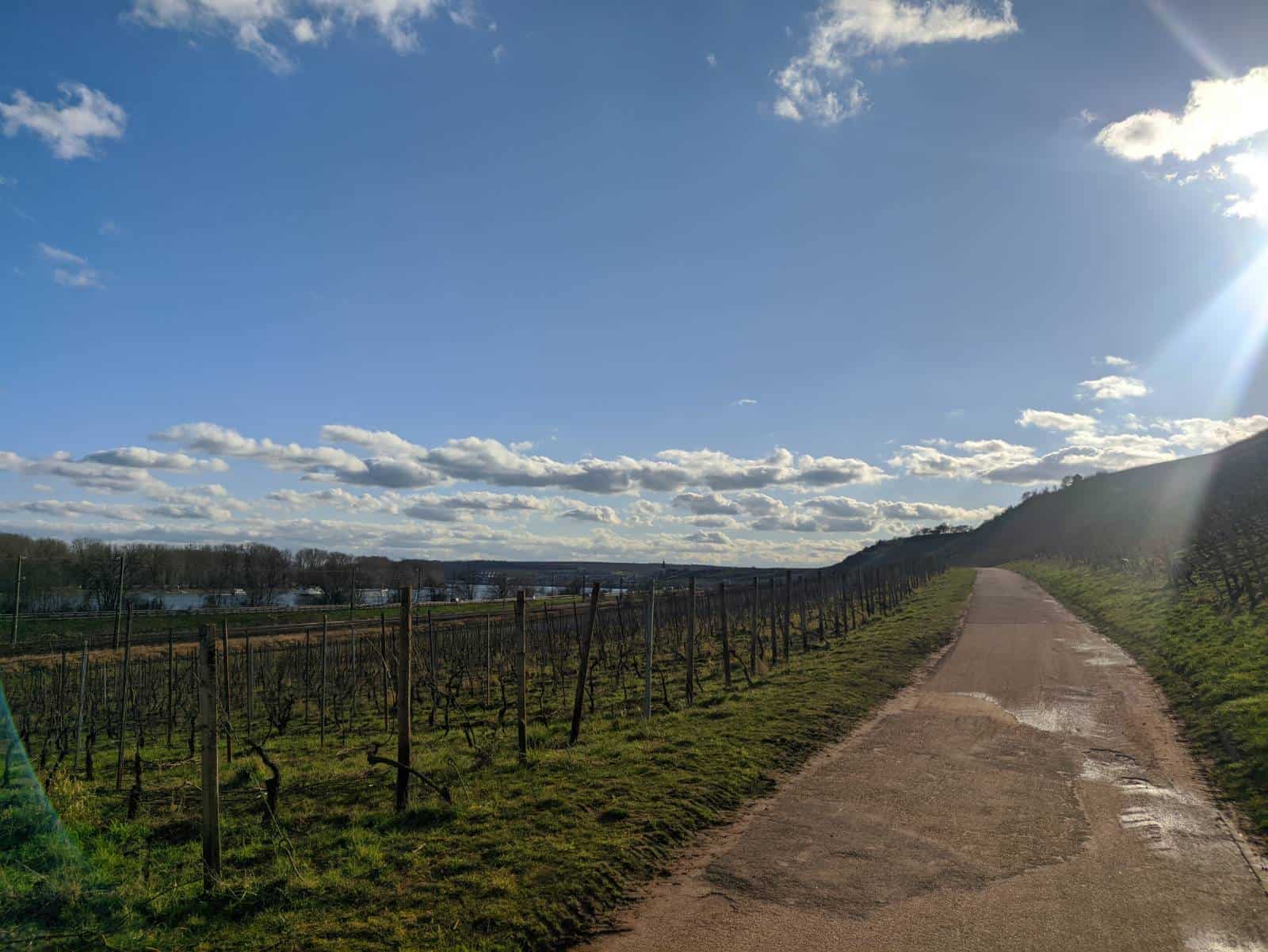
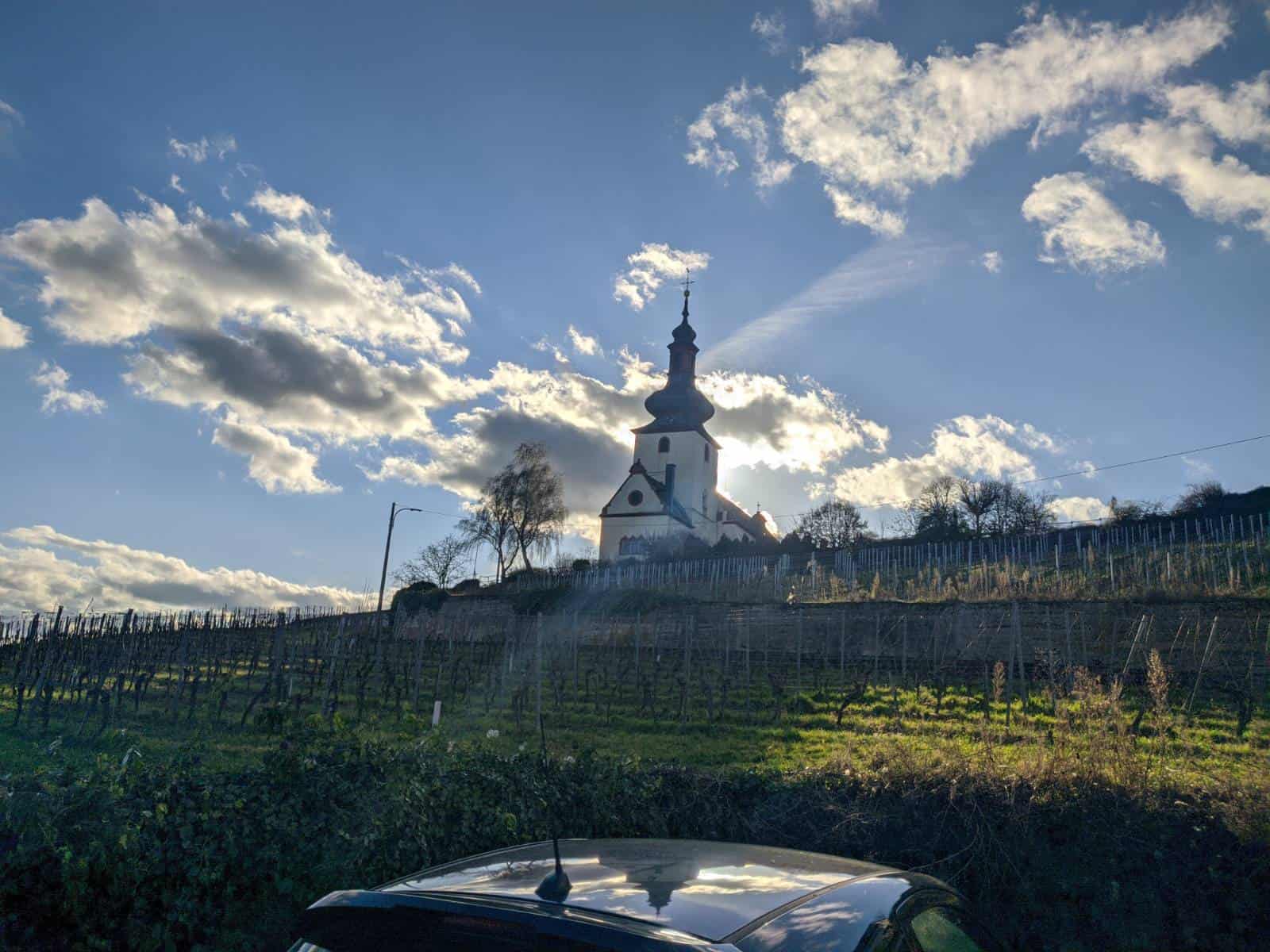
There was another reason I was excited: in Oppenheim I was to reunite with my family! During my sister’s half-term break, they had driven down to see me for a few days, minus the dog (oh, and brother!). At around 7pm, they arrived.
A brief hiatus
We drove around, exploring a handful of German towns over the next three days. These included Speyer, Tübingen, Bruchsal, and Stuttgart. The latter two destinations I would visit myself later down the road. On the third day, my dad joined me for a long hour of walking. We ambled south from Oppenheim (where we returned), passing workers in vineyards, and followed cycle lanes and dirt tracks. When we came to a village called Alsheim, we called it a day.
It was in that village where, early the next morning, this brief familial interlude came to an end. After subdued goodbyes, I started down the road. When I looked back, the car had gone. The open road unfurled before me.
The path of Martin Luther
After a little over three hours of walking that same day, I reached the town of Worms. I dropped off my bag in my hostel and stashed my wooden staff on the roof of a shed outside it.

My hostel was located directly opposite the town’s famed Dom. Its renown stems from it being the site of the 1521 Diet of Worms when Martin Luther was summoned by the Holy Roman Emperor Charles V and ordered to renounce his famous theses, all 95. After Luther’s obstinate refusal, the Edict of Worms which followed branded him a heretic. It was in Worms where the schism that had begun in Wittenberg four years earlier became patently clear. Lutheranism emerged as its own entity, and the path of European history channeled a new course, with new conflicts.
Here I stand; I can do no other. God help me. Amen.

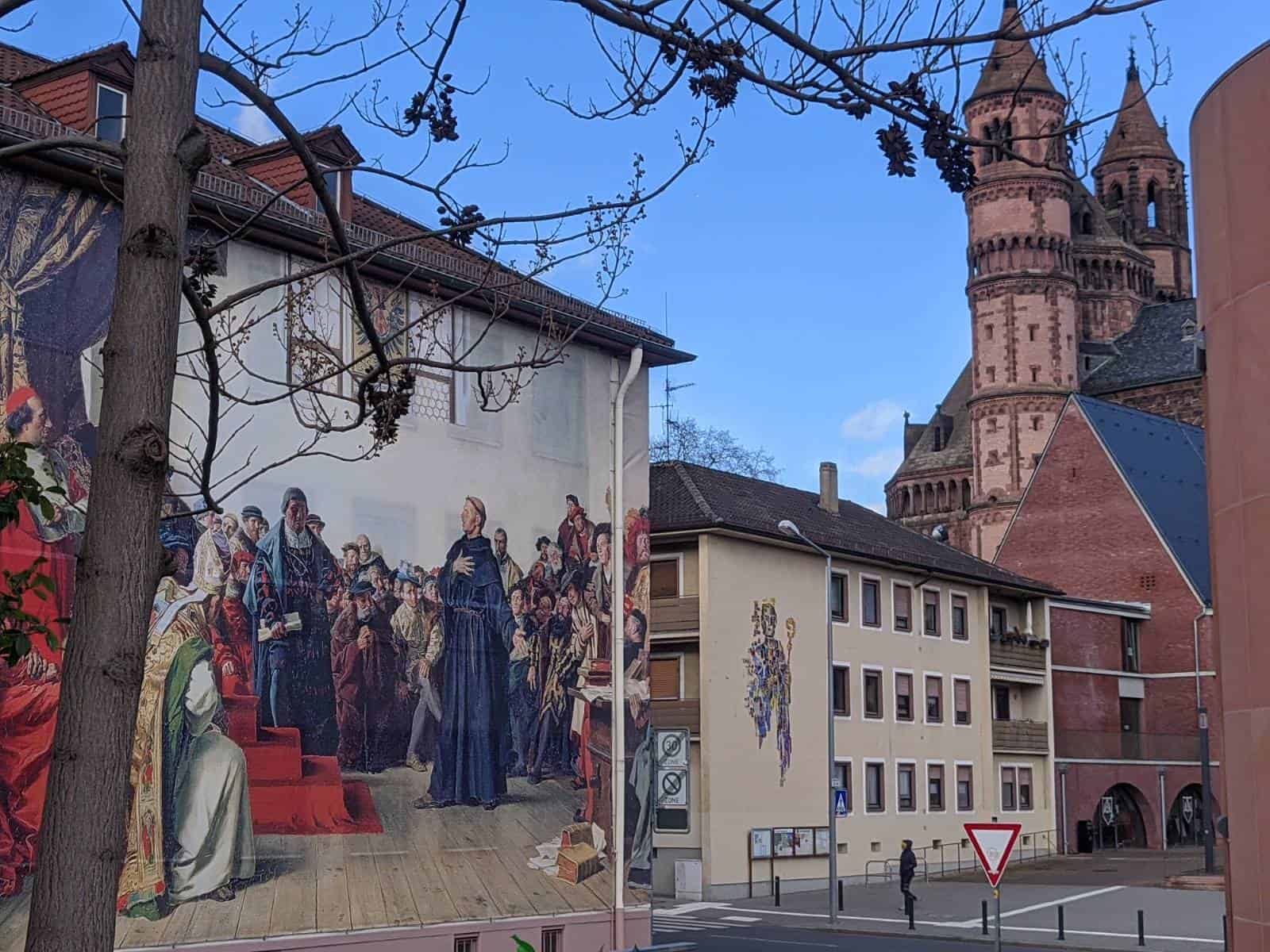
Truth be told, Worms was badly flattened in the war; apart from the Dom and Luther, there are a few old Jewish elements – synagogues, a cemetery – and not too much else old-build. Luckily, my hostel resided within perhaps the most stately building in town, overlooking the spires of the Dom, and a mural of Luther.

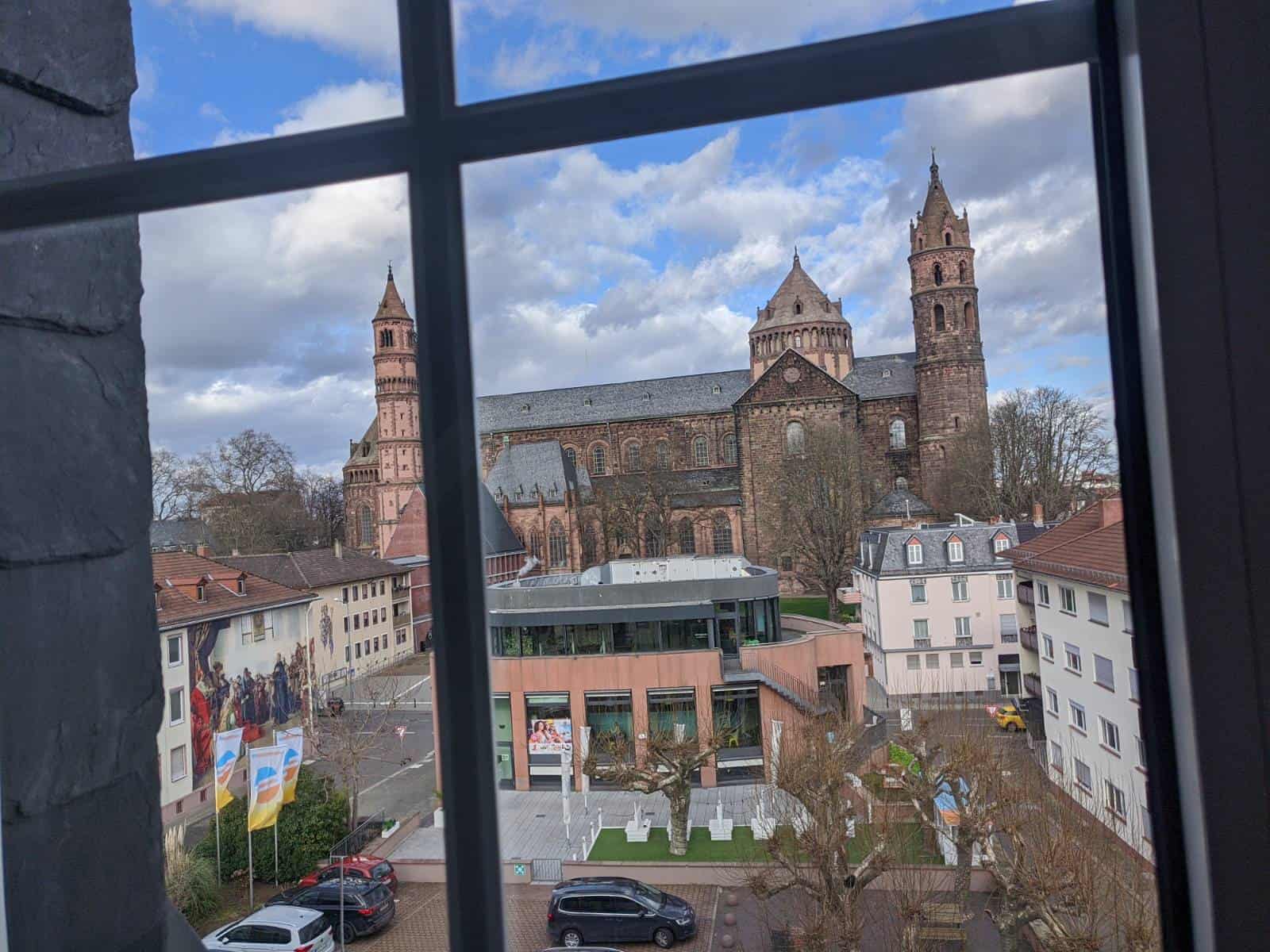
More farewells
An enormous chorus of tolling bells serenaded me out of the city the next day. I never noticed when exactly they stopped; the knells seemed to fade into the hills behind me as I walked.
It was an odd day, for around midday I was faced with the prospect of leaving the Rhine. Aptly, under grey skies, I washed off the dust from my hands on the gravel beach, and then crossed a bridge over the river. I turned my back and walked on.
Arriving in Mannheim later that day, I hid my stick on the banks of the Neckar river (a tributary of the Rhine) and ventured into town. I wandered around for a few hours, eating a bag of Pommes as I went. Mannheim was decidedly baroque in style, a change from the predominantly gothic architecture I had experienced thus far — it was a great Jesuit church and a tour of the Schloss that had kickstarted this theory.
I met my host Ashish around 7pm. After a long bath, we ate the Indian food he had prepared and discussed at length our couchsurfing experiences. He was around 40 years old, and had much experience with the hobby. Though examples allude me now, he told great tales of his times hosting others, travelling, and creating a couchsurfing group in Mannheim with weekly activities and meetings. Both die hard cricket fans, we discussed recent games and his time watching a game at Lord’s. (He also played for a local Mannheim cricket team! I cursed the fates that I should have passed through on a day without any matches or training. Imagine that: playing cricket in the middle of Germany!) We spoke until midnight, until exhaustion overcame me, and off I went to bed.
The first mountains
I followed the Neckar for most of the next day. Around lunchtime, I stopped at Ladenburg at Ashish‘s suggestion. Once called Lopodunum, I wandered around the half-timbered, painted buildings of the originally Roman town. I ate a hunk of bread in a square, taking in the amusing (or perhaps encouraging) sight of two churches – Catholic and Protestant – situated parallel to each other on adjacent lots.

I reached Heidelberg in the late afternoon and headed for the southern suburb of Kirchheim where I met Seb, my host for the next few days. (I later discovered that Kirchheim had once been entirely occupied by a community of American troops and their families that had been posted in Heidelberg after the war and only left in the late 70s). That evening, we ate chilli and drank a few beers whilst talking on his sofa. He was a penetration tester (a white hat hacker) at a local tech company; and, once he realised that I could follow most, if not the gist, of what he got up to, then the conversation quickly moved into his field. Discussion of the importance of open-source systems quickly developed into a debate on the best ways of implementing encrypted messaging systems for the average consumer. Privacy was the looming issue of the night, a subject on which our views aligned.
Do we have a fundamental right to privacy? Yes. How do you make that obvious to the masses? That’s hard to do. How do we build a structure for the future which is fundamentally privacy-friendly? Well, my friend, that’s harder still. Though, with their history, Germans get this.
Whilst no firm solutions were fashioned that night, you’ll be surprised to hear, it was clear we both felt relived to find that likeminded skeptics still harbour these fervent beliefs. There is still time. In the early hours of the morning, we both fell asleep on the living room sofa to the soft sounds of lo-fi music.
Heidelberg is found in a valley at the very beginning of the Odenwald mountain range. The first mountains of the trip! Spurred on, I walked around the university buildings first thing – this being the oldest university in Germany, after all – and then crossed the Neckar. I climbed partly up the mountain opposite the old town and Schloss, and found myself on the Philosophenweg (Philosophers‘ Way): a path with stunning views out over the town, mountains, and river. Later, following my descent back into town, I spoke on the phone with a friend for an hour or so, feeling very sophisticated as I sat outside a coffee shop in a quaint alleyway.
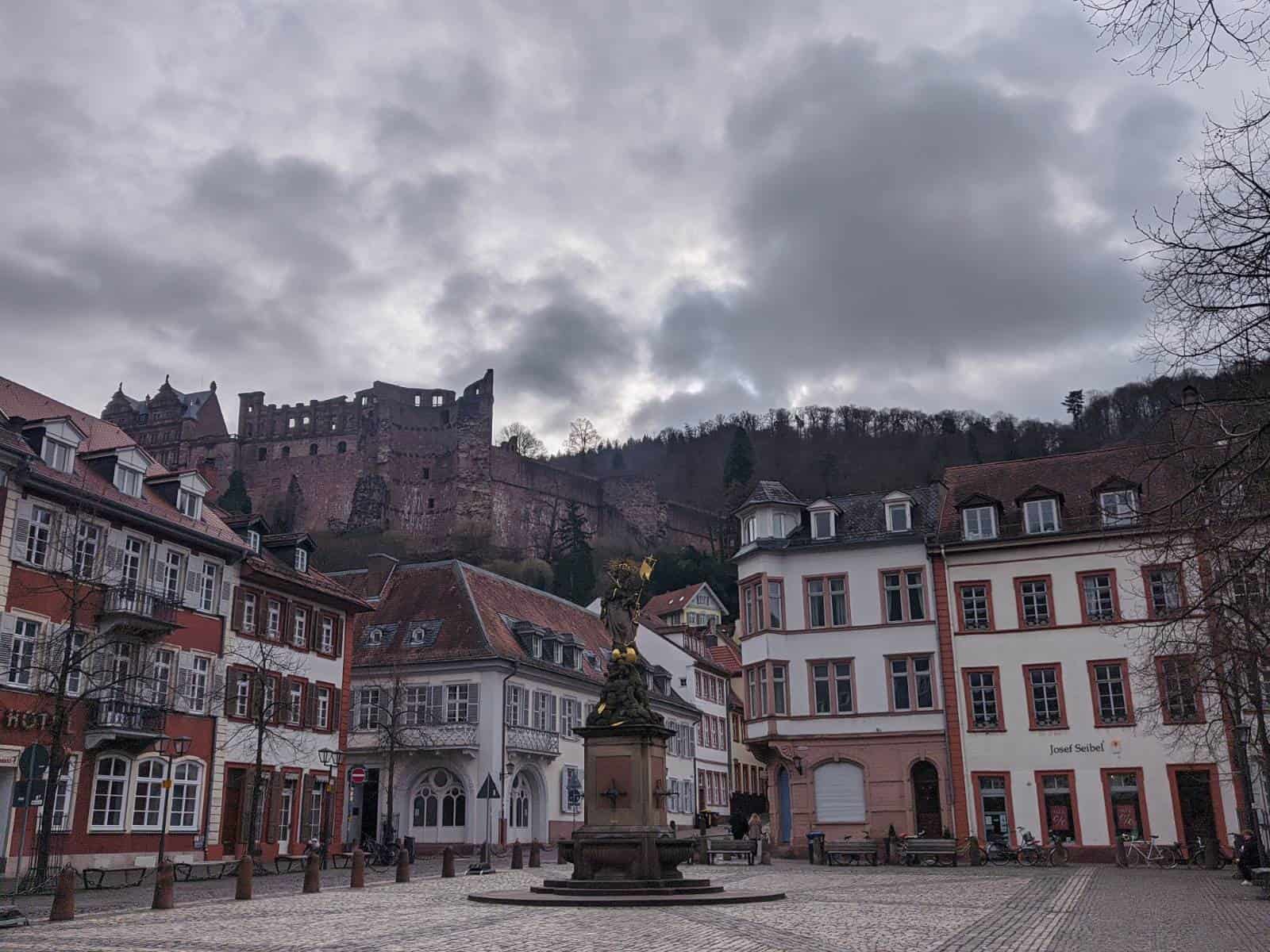

In the mid-afternoon, sitting in a different Heidelberg café, I read the signs on the wall detailing in great length Goethe’s visit to this very joint a few centuries prior. I reflected on the drive that the poet must have had; Goethe somehow seems to have found the time to stay at every public house, inn, and pub in Germany. Or at least, that’s what they claim. If there are three certainties in this part of Germany, it’s that, in any given town, there is a square named for Schiller, a church, and an inn which at one time hosted Goethe. It’s a small world after all, eh. I headed off to find The Red Ox inn and take the obligatory selfie…
Steady progress
I departed Heidelberg under entirely blue skies. Wisps of cloud did emerge later, but they only served as slender streaks of ornamentation, drawing out the azure pigments of the canvas above. Notably, I stopped for lunch in the town of Walldorf: the birthplace of John Jacob Astor, and the namesake of the famous hotel founded by the family. I left town on a sequence of cycle “highways” which took me up and over the intersections below. It was somewhere along here where a middle-aged woman, aptly mounted on an omafiets, drew up alongside me and, gesturing at my stick and pack, asked if I was a Jakobspilger. A pilgrim of St. James’s. “Almost”, I replied. Though not quite.


The next few days saw me walking through a steady cycle of woodlands and open fields, with the odd village in between. I passed through Bruchsal and Pforzheim in this way. They were overcast days, though it was bright and the clouds above never truly threatened rain. However, as I zoned in on the outer edges of Stuttgart, heavy white flecks began to fall. Though this was hardly the begetter of the white fields of, say, Bruegel’s paintings, it was a welcome sight. It was snowing as I reached Stuttgart. Barely.
There’s much more on the way, folks. Don’t you worry.

Loving your story. You sound like you are having a blast. Take care, Mat.